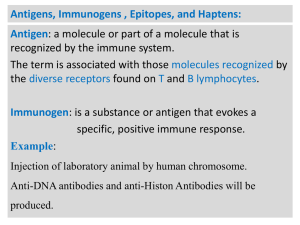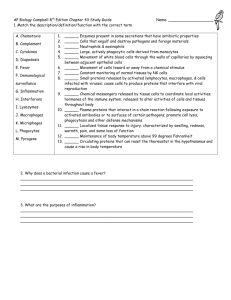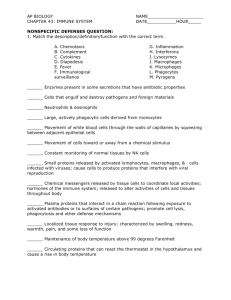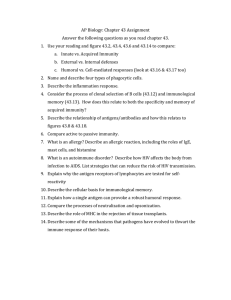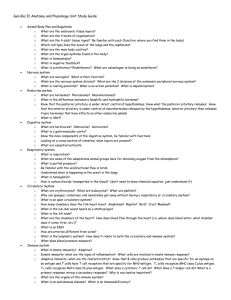Antigens, Immunogens, Epitopes, and Haptens
advertisement
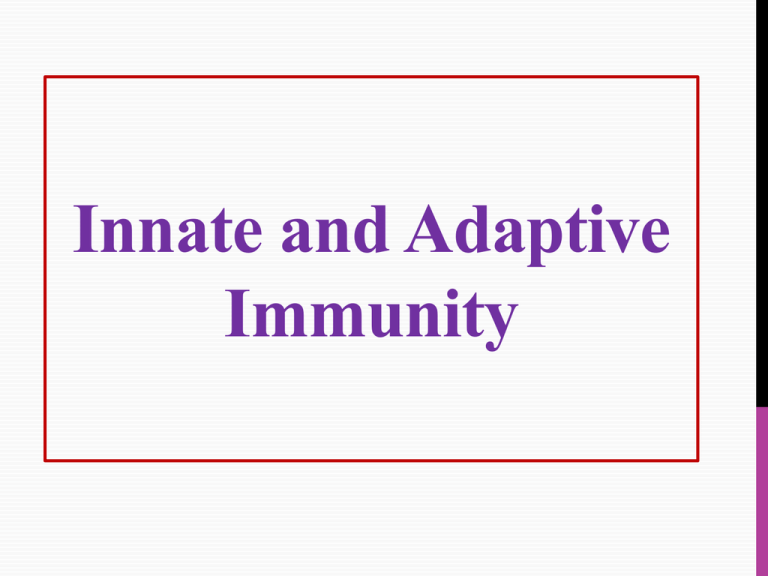
Innate and Adaptive Immunity Innate (Natural) Immunity: Inborn resistance. present the first time a pathogen is encountered (does not require prior exposure). Not specific. not modified by repeated exposure to the pathogen. Adaptive (Acquired) Immunity: weak or absent at the first exposure. Specific. increases dramatically with subsequent exposures to the same pathogen (memory). Components of innate immunity: Cell mediated immunity. Humoral (soluble) immunity. Types of adaptive immunity Cell mediated immunity. Humoral (soluble)immunity. Cells of Innate Immunity: Phagocytes: - Monocytes and macrophages: blood stream and tissues. - Dendritic cells: lung, skin and GIT mucosa. Granular leukocytes: - Neutrophils, and eosinophils. - Basophils and mast cells. Natural killer cells (NK). Soluble Mediators of Innate Immunity: o Proteins and enzymes. o Cytokines & type 1 interferons. o Complement (C3b: opsonization). o Proteins and Enzymes A variety of proteins and enzymes (present in human blood and tissue fluids) are considered the first part of innate immunity. Example: C reactive protein (CRP), lysozymes and defensins. Proteins and enzymes Major microbial targets Effects Lysozyme and defensins Bacterial wall and membrane digestion CRP Polysaccharides of microbes Opsonization Mannose binding proteins Mann glycoprotein Opsonization and complement activation o Cytokines and Type I Interferons: Cytokines: IL-1, IL-6, IL-12, and TNFα produced by activated phagocytes. Type I interferons: INFs are rapidly produced, within minutes by infected cells (virus infection). INFs activate phagocytosis and apoptosis of infected cells. • • IFN- α produced by dendritic cells. IFN-β Produced by fibroblasts. Cellular and Humoral Adaptive Immunity: Immune cells: - T lymphocytes - B lymphocytes - N.K cells. Soluble mediators: - Cytokines: IL-2, IL-3, IL-10,IL-13. - Interferons: INF-γ (Gamma). - Complement. Soluble and cell-bounded proteins: -The Immunoglobulins. Complement Cytokines: IL2, IL3, IL10 & IL13. Interferons: IFγ Immunoglobulins. Cytokines: IL1, IL6, IL12 & TNFα. Interferons: IFα and IFβ. n Phagocytes: monocytes, macrophages & DC Granular leukocytes NK cell T lymphocyte & B lymphocytes Antigens, Immunogens , Epitopes and Haptens Antigen: Is a molecule or part of a molecule that is recognized by the immune system. Immunogen: Is an antigen that evokes a specific, positive immune response. Example: Injecting a laboratory animal by human chromosome anti-DNA antibodies and anti-histons antibodies will be produced. Epitopes (The Antigenic determinants): The smallest part of an antigen or immunogen that can be recognized by the B & T cells receptors. So it is the basic recognition element. N A single antigen molecule may have several different epitopes. Immunodominant epitope is an epitope that can stimulate a greater antibody response than others. N epitopes Immunogenicity and Properties of Immunogen: Immunogenicity is the ability of immunogen to activate immune response. Properties of Immunogen: o Foreignness. o Size. o Chemical nature o Complexity. Foreignness: Immune system can discriminate between foreign and self substance (self & non self). Size: Molecular weight of at least 10,000 Dalton (10 kDa). Chemical nature: -Proteins (polypeptide) are good immunogens. -Carbohydrates, steroids, and lipids are poor immunogens. Chemical complexity: As the chemical complexity increases; the immunogenicity increases. N Homopolymers are poor immunogens regardless of size, while heteropolymers are strong immunogens. Proteins are heteropolymers (different amino acids). N Which of these antigens is more immunogenic? epitopes Epitopes Recognition B cell receptors can recognize epitopes whether they are: Free soluble molecules. Surface-bound molecules. Degraded fragments. T cell receptors can bind only to epitopes which are surface-bound molecules. Superantigen: o Is a substance such as a bacterial toxin that is capable of stimulating multiple T lymphocytes, leading to release of relatively large quantities of cytokines. o Phagocytosis process is not required for this type of activation. N Hapten: Small, usually non-biologic molecules that bind to immune cells receptors but cannot by themselves induce a specific immune response. (Land-Steiner’s experiment). Injected a mice with: hapten carrier (protein) Hapten + carrier carrier No immune response anti carrier anti-hapten +anti- T-cell Dependent and T-cell Independent Antigens: Antigens are classified as either T-cell dependent or T-cell independent. T cell dependent antigen activates immune system depending on Tlymphocytes. T-cell dependent antigen T-cell independent Antigen Complex Simple Chemical nature Proteins, glycoprotein, and lipoproteins Antibody - class induced IgG, IgM, IgA, IgD, and IgE Polysaccharide; bacterial Lipopolysaccharide. Only IgM Immunological Memory yes No Present in most Pathogens yes No Structural properties
